Scientists are making strides in explaining a mysterious disease that laid millions of West Coast sea stars to waste last year, while meeting signs of recovery and rebirth with a mixture of hope and …
This item is available in full to subscribers.
We have recently launched a new and improved website. To continue reading, you will need to either log into your subscriber account, or purchase a new subscription.
If you had an active account on our previous website, then you have an account here. Simply reset your password to regain access to your account.
If you did not have an account on our previous website, but are a current print subscriber, click here to set up your website account.
Otherwise, click here to view your options for subscribing.
* Having trouble? Call our circulation department at 360-385-2900, or email our support.
Please log in to continue |
|
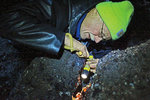
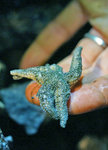
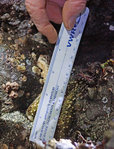
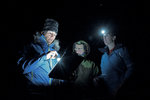
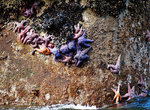
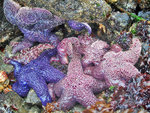
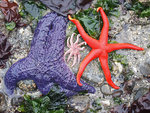
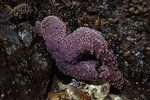
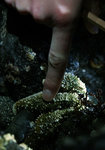
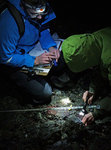

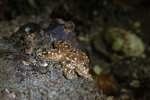
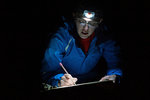
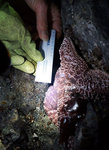
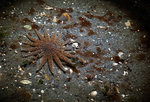
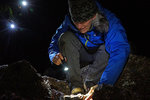
Scientists are making strides in explaining a mysterious disease that laid millions of West Coast sea stars to waste last year, while meeting signs of recovery and rebirth with a mixture of hope and skepticism.
A fever pitch of mass die-off reports, the first signs of which appeared along the Olympic Peninsula’s Pacific coast in June 2013, has apparently died down since decimating sea star populations from Alaska to Mexico last summer, leaving some observers hopeful that the animals might be back on the upswing.
“The thing we’re most concerned about is juvenile recruitment,” said Melissa Miner, a Bellingham resident who, for the past 20 years, has worked as a research associate with the University of California, Santa Cruz’s Multi-Agency Rocky Intertidal Network (MARINe), a consortium of research groups collecting comparable data from more than 200 marine monitoring sites from Southeast Alaska to Mexico. “It’s important that we know where people are seeing juvenile stars.”
Since last fall, some monitoring sites have reported an apparent resurgence of baby stars, including a site near Miner in Bellingham.
While spotting young stars so soon after an unprecedented die-off is encouraging, Miner warns that those stars still have a long way to go to replenish populations.
“It’s not a coast-wide phenomenon at all,” said Miner, noting that as few as four of 70 long-term sites, mainly along Oregon and California coastlines, have seen greater than normal numbers of new juvenile stars. “It’s just being seen at a few isolated sites. There are very few years where we’ve seen much in the way of recruitments.”
LOCAL TEAM
In their most recent visit, on Feb. 16, Port Townsend Marine Science Center (PTMSC) staff and volunteers hoped to spot young stars in either of their two, 390-square-foot plots situated on a breakwater jetty at Indian Island County Park. Although they saw some sea stars outside their plots, none were seen inside.
“I was trying really hard to find juveniles and I couldn’t find any,” said Chrissy McLean, PTMSC marine program coordinator. “I was anticipating being able to find at least one juvenile because they were here last time we came out.”
Some half a dozen staff and volunteers, equipped with flashlights and measuring sticks, set out under cover of a dark, star-filled February sky, to crawl over barnacle-covered riprap and peer under rocks in search of sea stars.
That search marked the marine science center's sixth visit to the site and the first anniversary of counting and recording measurements of sea stars there.
OUTBREAK
In February 2014, the team set up its first intertidal jetty plot after watching a record number of mottled stars grow sick and die during the previous fall and winter in the center’s tanks, which are fed by unfiltered Puget Sound seawater continuously pumped from around the center’s home off the beach at Fort Worden State Park.
“It was kind of like a freight train,” McLean recalled recently, adding that it's normal for one or two of the center’s stars to get sick each year during warmer summer months. “We could see it coming and coming and coming, and it just plowed through so many animals. We have never experienced anything of that level.”
Lethargic stars would begin to deflate as their arms twisted unnaturally, developing white lesions and eventually breaking away from their bodies one by one. Onset was rapid, typically killing stars in a matter of days as their bodies disintegrated, leaving little more than a pile of goo.
Researchers dubbed the mysterious sickness “sea star wasting disease” after first noticing telltale symptoms in ochre stars in June 2013 off Starfish Point, two miles north of Kalaloch along the Olympic Peninsula’s Pacific coast.
In the months that followed, mass die-offs of both subtidal and intertidal species were reported simultaneously in places as geographically disparate as Vancouver, British Columbia, and Monterey, California. Unusually large populations of sunflower and ochre sea stars, both considered keystone species, were decimated.
Sea star wasting disease was documented in the late 1970s and again in the late 1990s, but this time a greater diversity of stars have died over a wider geographic area during a longer span of time.
DENSOVIRUS
In spite of many theories, no one knows what might have triggered such widespread wasting, although scientists have identified a densovirus, a virus-like microorganism, associated with symptomatic stars.
A December 2014 paper published in Proceedings of the National Academy of Sciences and written by some 25 scientists suggests the culprit is a microscopic, water-borne, infectious virus rather than environmental pollutants, such as the oft-suggested radiation from the 2011 Fukushima Daiichi Nuclear Power Plant disaster.
Those scientists detected the virus in plankton, sediments and other marine life, suggesting it persists in these marine environments and can be spread without direct contact with an already-infected animal. They found the virus in a Connecticut aquarium where mass die-offs had not been observed, as well as in preserved sea stars from 1942.
“I’m not convinced the disease isn’t already everywhere,” said Miner, who is one of the paper’s authors. “It’s likely that other environmental factors have pushed stars to the limit and that’s when we see these mass wasting events.”
LOCAL PLOTS
Upon establishing a second plot adjoined to its first in May 2014, the center’s team found a total of 68 stars, 20 percent of which showed signs of sickness.
Of the 22 stars found in a single plot in February 2014, 5 percent showed signs of sickness.
Shannon Phillips, an AmeriCorps Marine Exhibit educator at PTMSC, said those stars were mostly full-size adults.
“Since May, we’ve been seeing a different trend in the size of sea stars out there,” she said.
In July 2014, the team found a total of six stars – all adult ochre stars. Two showed signs of sickness.
The team also spotted blood stars, sunflower stars, mottled stars and other ochre stars outside the plots, some of which were juveniles. Many appeared to be in various stages of sickness.
Those, Phillips said, were some of the last full-size stars the team has seen in the plots.
“It’s been since July that we’ve seen a mottled or ochre star larger than 16 centimeters,” she said. “There has been a trend toward smaller sea stars in our plots.”
In August 2014, the team found 15 stars, one of which showed signs of sickness.
“By that point we had already seen the majority of the wasting,” Phillips said.
“It was very different from what we expected to see,” McLean said. “We knew there was disease at the site. In our tanks, of the animals affected, most had died, so that’s what we anticipated seeing at our site in the spring, and we did. Those that were left in the summer were in good condition; there just weren’t many left. So the question is, where did these animals go?”
Those low summer counts could signify a local mass die-off or it could mean stars were choosing not to hang out on the drier, more sun-soaked jetty, she said.
“We would expect to see fewer in the summer anyway because of low tides and sun exposure, and stars tend to move farther down into the water because of that,” said McLean, adding that her next question was whether fall 2014 would be a repeat of the “freight train” that hit in fall 2013. It wasn’t.
Upon returning in November 2014 during an evening low tide, the team found 18 stars, with one showing signs of sickness. Several juveniles were found outside the plots and well hidden under rocks.
During the most recent visit in February, the team found 29 stars, all of which were healthy and none of which were juveniles, aside from a couple of young sunflower stars spotted outside the plots.
“It’s interesting that we are now seeing more sea stars than we have been since July and August,” said McLean, adding that the team also found a greater diversity of stars in February. “This most recent time it was nice to not see wasting, but that doesn’t mean there won’t be more.”
Miner said it’s possible there were more juveniles at PTMSC’s plots than the team spotted.
“On that riprap patch, they could hide really deep,” she said, pointing out that baby stars often hide from hungry adults in deep crevices. “There’s definitely an inverse relationship between adult abundance and juvenile supply.”
Regardless, McLean said those stars that the team did see are likely survivors.
“During this last visit, we saw animals that, just by their size, I would say are not last year’s young,” she said of the relatively smaller-than-normal adult stars. “They are animals that would have had to survive this wasting event.”
LOCAL TANKS
As for the stars in PTMSC’s tanks, 16 of an original 75 stars remained at the end of 2014. While many a mottled, ochre and sunflower star fell victim to wasting, others were more resistant, such as leather stars and six-rayed stars.
“We have tanks that weren’t affected at all this past year,” said McLean, adding that of an original 19 ochre stars, one became sick but recovered and is still alive today. “We had one ochre star that was sick and survived, and a few other species that were not affected, which were those that in general were less affected in the wild.”
Phillips said the center has not seen a new case of wasting in its tanks since September 2014, and those stars that have survived are a symbol of hope for her.
“To me, it’s just a reminder that with many diseases like this one, there are animals that can survive,” Phillips said. “That’s a story of hope for me. One would have to think there are stars in the wild that have gone through the wasting and have recovered.”
McLean said that what the team found at the plots in February gives her hope, as well.
“In February, we saw a greater diversity of older animals that were also healthy,” she said. “To me, that means they were able to go through the wasting and be able to recover or heal themselves in some way.”
Phillips is compiling the center’s annual report on its citizen science projects, which is due out in early April and will be available on the center’s website:
ptmsc.org. The center’s data collected on sea stars over the past year will be included in that report.
UNDERSTANDING UNKNOWNS
Though hopeful for signs of recovery, Miner and McLean are acutely aware of how much researchers don’t know about this wasting syndrome and the marine environments of sea stars, making attempts to predict recovery a mere guessing game.
“We’re not seeing large numbers of sick animals anymore, but there’s also many fewer animals to observe, whether that’s because the disease has passed or because they’ve recovered,” Miner said, pointing out that one or two years of data can only be so revealing. “That’s why collecting long-term data is so important – to be able to distinguish between natural variation and the real change.”
Researchers will likely need to monitor sea stars over several summers before making conclusions about a cause.
“One of the big missing pieces is what caused the mass wasting to happen in the first place,” McLean said. “We don’t have a clear understanding of that and I don’t know if we ever really will.”
It would be presumptuous to conclude all sea star wasting events have had a common cause, Miner said.
“Sea star wasting disease is really just a blanket term to describe the symptoms we’ve seen during wasting events over the decades,” she said. “There isn’t anything or any group of factors that seem to clearly explain the emergence of the disease.”
In trying to explain these mass die-offs, many point to environmental and population stressors such as increased water temperatures, storms, starvation, overpopulation and infection.
Miner said that while warmer water does cause stress in sea stars, it doesn’t stand up as a possible cause because of this wasting event’s geographic spread across differing climates. Overpopulation also fails to explain this massive die-off, she said, because some sparsely populated areas have been hit as hard as densely populated areas.
“It might help us to focus on a more regional scale,” said Miner, who has noticed that water temperature changes have a greater impact on sea stars in Washington’s waters than in California's, for example. “There’s just so many things that we don’t understand.”
One of those unknowns is whether changes in pH levels play a role.
“We’re not going to go out and try to get better pH data, because it’s really expensive,” she said. “We’re not even at the point where we could collect that kind of data in a reliable way.”
ECOLOGICAL RIPPLE
Researchers are also looking into the ecological consequences this mass die-off could have on other forms of marine life in subtidal and intertidal communities.
“This influx of recruits we’ve seen in some areas is encouraging, but we’re also interested in how this loss will impact local communities in general,” Miner said. “We are capturing [data on] all the species at a given site and looking to see if those populations change.”
In spite of that hope in a new generation, scientists are not yet declaring that what may be the most widespread, largest known marine wildlife die-off ever documented is a thing of the past.
“Part of this is being patient enough to watch it play out,” said McLean. “I think the most interesting information may not come out for a few years, once we’ve seen much more.”
Researchers are now keeping an eye on other echinoderms, such as
sea urchins and sea cucumbers. Wasting has been observed in those animals in southern California, and researchers are asking citizen observers to report any sign of such a spread.
“So far, nothing makes us think this disease has spread to other echinoderms, at least on any large scale,” Miner said, adding that other echinoderms experience small amounts of normal annual wasting when waters warm, as do sea stars. “We’re seeing urchins in southern California with lesions in areas where stars were dying this last fall, but water temperatures have been ridiculously warm down there. It could be this disease, but it could also be bacteria. If we start to see that farther north, we might change our minds.”
McLean said she has yet to see signs of wasting in other echinoderms, either in the wild or in the center’s tanks.
Researchers such as Miner are also looking at whether the loss of keystone species such as ochre and sunflower stars will give rise to increasing numbers of other animals, such as mussels.
A keystone species, a concept introduced by University of Washington researcher Robert Paine in his 1969 paper about ochre sea stars, maintains an ecosystem’s balance of diversity. When ochre sea stars were removed from an intertidal area, mussels seized the opportunity to expand their territory.
In May 2014, Miner said some areas could see local extinction, yet while wasting appears to have decimated sea star populations coast-wide by summer 2014, there are survivors.
“I think it's important to note that we're still seeing sea stars – they're not gone for good,” said McLean. “That concept of localized extinction, that hasn’t happened in our area that we have seen. That’s really positive news. There are a handful of individuals out there and that means they have a chance of recovering.”
FEDERAL HELP?
Miner said Washington’s network of monitoring sites is well-dispersed and capable of providing long-term data, although resources remain limited for expanding the scope of monitoring. She doesn’t expect to seek much more grant money to develop more monitoring sites in Washington, but a bill first introduced into the U.S. House of Representatives in September 2014 by Washington Rep. Denny Heck to address marine disease emergencies remains on the table.
The Marine Disease Emergency Act would be set up to identify such emergencies and develop a rapid response plan. It would declare sea star wasting an emergency, triggering efforts to stop its spread.
The bill is sponsored by the Puget Sound Recovery Caucus, founded by Heck and Rep. Derek Kilmer, and would seek to improve access to and sharing of research, and to set up a U.S. Treasury Department fund for public donations as well as a working group to advise the secretary of commerce.
EXPANDING THE SEARCH
McLean and her local team plan to continue monitoring their Indian Island plots for at least another year.
“It’s a challenging effort because it takes resources and people, and we haven’t had specific funding for this,” she said, acknowledging that recovery won’t come quickly, if it does at all, and will require long-term monitoring. “I wouldn’t expect to see that [local] population rebound for a couple of years. So I think this a good opportunity, having these plots, to pay closer attention to what’s happening out there and get systematic data.”
Other researchers – at Cornell University, the University of Rhode Island, Brown University, Western Washington University and Seattle Aquarium – continue to study the pathology and infectiousness of the disease.
“There’s a lot of interest in Washington,” Miner said. “It’s been great. If we can stick with it, we’ll have a nice data set to look at in a few years.”